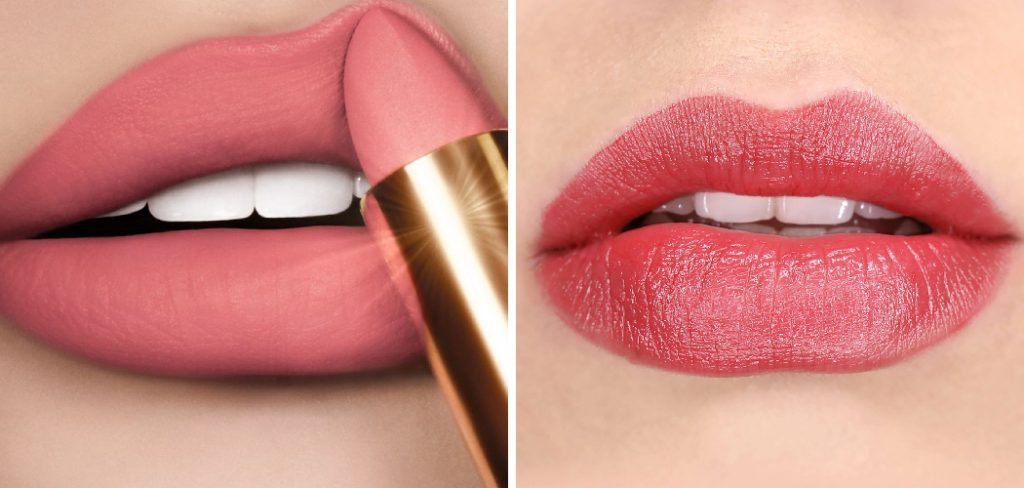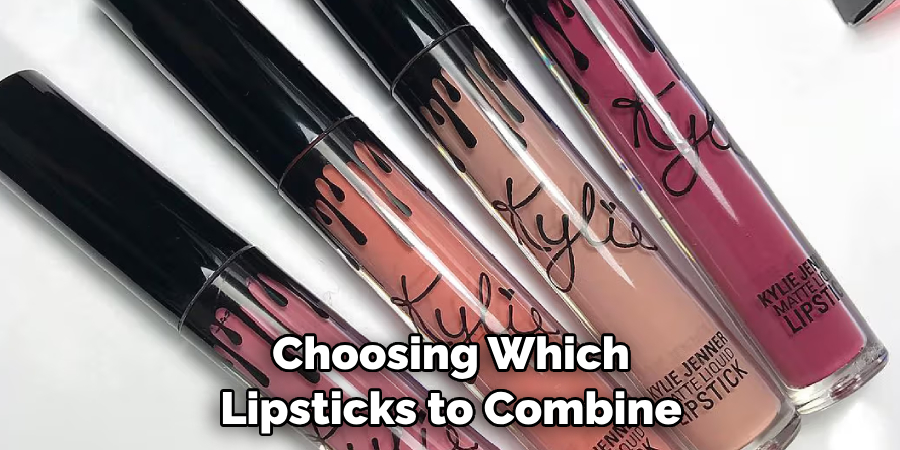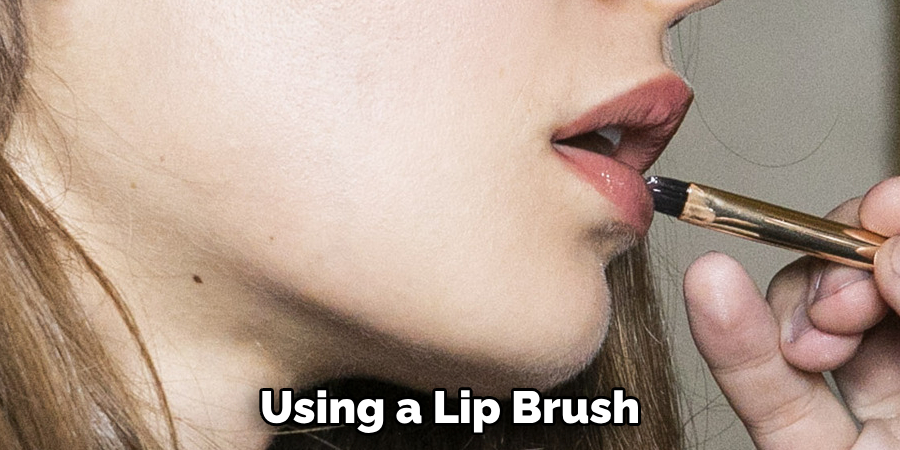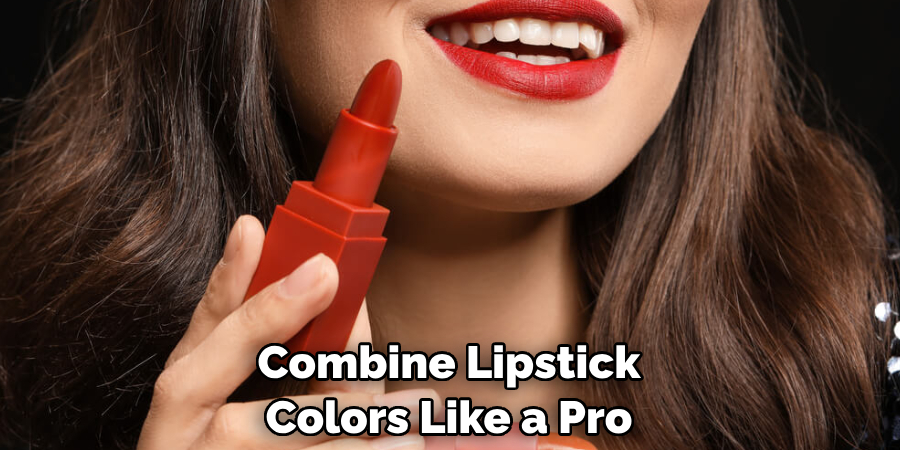Are you looking for new and exciting ways to express your personal style? Finding innovative fashion ideas can be so much fun, whether it’s through clothes or makeup. If you are passionate about makeup, why not combine different lipstick colors for a unique look? Learning how to mix your lipsticks successfully can help create beautiful combinations to take your looks to the next level.
Combining lipstick colors can seem intimidating at first, but with a little bit of practice and some basic knowledge about color theory, you can achieve stunning results. Additionally, experimenting with different lip colors can also save you money, as you won’t need to buy new shades every time you want a different look.

In this blog post, we’ll explore some tips and tricks on how to combine lipstick colours in order to achieve an effortlessly stylish look that will turn heads!
What Will You Need?
Before we dive into the different techniques, let’s go over some basic materials you’ll need.
- Lipsticks: The most important ingredient, obviously. You can choose any shades you like, but try to make sure they complement each other.
- Lip Balm or Primer: This will be your base, and it’s essential for creating a smooth and long-lasting finish.
- Makeup Brushes: While you can certainly use your fingers, using makeup brushes will give you more precision and control over the application process. You can use a lip brush or an eyeshadow blending brush to mix colors together.
Now, let’s get started!
10 Easy Steps on How to Combine Lipstick Colours
Step 1: Prepare Your Lips
You need to be in the best possible condition to ensure an even and smooth lipstick application. Start by removing old lipstick, then gently exfoliate your lips to remove dead skin cells. This can be done with a soft toothbrush or a lip scrub. Next, apply lip balm or primer. This not only keeps your lips hydrated but also provides a smooth base for the lipstick to adhere to.
Step 2: Know Your Colours
Before we start combining colors, it’s essential to understand some basics of color theory. The three primary colors are red, yellow, and blue. When mixed in equal amounts, these colors create secondary colors – orange, green, and purple. Keep this in mind when choosing which lipsticks to combine.

Step 3: Start with Complementary Colours
Complementary colors are located opposite each other on the color wheel, such as red and green, blue and orange, or yellow and purple. Combining these shades will create a bold look that is sure to make a statement. If you’re feeling adventurous, give it a try!
Step 4: Experiment with Analogous Colours.
Analogous colors are next to each other on the color wheel. This means they have similar hues and blend well together, creating a harmonious and subtle look. For instance, you could mix a deep plum with a lighter pink or a coral with an orange-toned red. Don’t be afraid to get creative and try out different combinations!
Step 5: Using a Neutral Base
One clever trick for combining lipstick colors is to start with a neutral base. This could be a nude or beige lipstick that matches your natural lip color. Apply it all over your lips, then add your chosen color. This allows the top color to really pop, and the neutral base can help blend different shades smoothly. Blending is key in creating a gradient or ombre effect, where one color transitions into the next. Remember, practice makes perfect!
Step 6: Try the Ombre Effect.
The ombre effect, a technique that features a seamless gradient from one color to another, has become a staple in modern makeup artistry. For this, choose two lipstick colors that complement each other. Apply the darker shade on the outer edges of your lips and the lighter color in the middle. Blend them together where they meet to create a beautiful gradient look. You can always add more product and blend again until you achieve the desired effect. With the ombre technique, your lips will look fuller and more dimensional.
Step 7: Mix and Match.
Don’t feel limited to only two colors – it can be exciting to mix and match multiple shades for a truly unique look. You could try blending three colors, applying each color to a different part of your lips. For example, use one color on the outer edges, a second in the middle, and a third at the center of your lips. Remember to blend well so there are no harsh lines. Experiment with this technique until you find your perfect color blend. After all, the sky’s the limit when it comes to expressing your unique style through makeup!
Step 8: Use a Lip Brush for Precision
When combining lipstick colors, precision is key. A lip brush will provide more control and accuracy than applying lipstick directly from the tube. Start by loading your brush with the first color, and apply it to your lips. Clean your brush, then switch to the next color. Blend the edges where the two colors meet to create a seamless transition. Using a lip brush also allows you to build color gradually, giving you more control over the intensity and overall look.

Step 9: Layer for Depth and Intensity
Layering is another great technique to combine lipstick colors for a more dynamic and intense look. Apply your first lipstick color as you normally would. Then, gently dab on a second color with a brush or finger, focusing on the center of your lips. This creates a multi-dimensional look that can add depth and intrigue to your overall makeup look. Remember to blend well to ensure a seamless transition between colors.
Step 10: Lock in Your Creation
Once you’ve achieved your desired look, it’s time to set your lipstick to ensure it stays in place. Use a lip liner in a shade close to your lipstick to outline your lips. This creates a barrier, preventing the lipstick from bleeding and increasing its longevity. Alternatively, consider applying a clear gloss or lip balm on top of the lipstick. Not only does this add a nice shine, but it also helps seal the color, ensuring your beautifully combined shades last throughout the day. Don’t forget to check your lipstick occasionally and perform any necessary touch-ups. Practice these techniques, and you’ll soon become an expert in combining lipstick colors to create stunning new shades and looks.
By following these steps, you can effortlessly combine lipstick colors to create unique and personalized shades that match your style and mood. Don’t be afraid to experiment with different techniques and color combinations – soon, you’ll become a pro at creating stunning lip looks!
5 Additional Tips and Tricks
- Experiment with Primary Colours: Start your lipstick color combination journey with the three primary colors: red, blue, and yellow. Understanding how these hues mix and match will provide a foundation for more complex combinations.
- Understand Undertones: Knowing the undertones of your lipsticks can help you create harmonious color combinations. For instance, lipstick with warm undertones will blend well with another warm-toned lipstick.
- Keep a Neutral Lipstick in Your Collection: Neutral lipstick, such as nude or brown shades, can be used to tone down or balance out brighter colors. If you struggle with too much boldness when mixing two lipsticks, use a neutral shade to calm things down.
- Balance with Makeup: When combining lipstick colors, consider your overall makeup look. If your eye makeup is bold, opt for muted lipstick tones, and vice versa.
- Practice Layering: Different lipstick colors can help you achieve a unique shade. Start with a lighter color as your base, and add a darker color on top, blending well for a seamless look.
With these extra tips and tricks, you can combine lipstick colors like a pro. Remember, the key is to have fun and embrace your creativity.

5 Things You Should Avoid
- Avoid Clashing Tones: When combining lipstick colours, avoid mixing warm and cool tones as they can create a clashing effect. Stick with lipsticks that have similar undertones for a harmonious look.
- Ignoring Your Skin Tone: While experimenting is encouraged, it’s important to consider your own skin tone. Certain colour combinations may not complement every skin tone, so it’s crucial to find what works best for you.
- Overdoing with Bright Colours: While bright colours can be fun, avoid mixing too many together. This can make your lips look too loud, which might not gel with your overall makeup. Balance is key.
- Not Blending Well: If you’re layering multiple colours, blending is crucial. Not blending well can result in a patchy or uneven look. Invest in a good lip brush for this purpose.
- Ignoring Lip Condition: Before applying lipstick, ensure your lips are in good condition. Avoid applying lipstick on chapped or dry lips, as the colour won’t adhere well, and the final look might appear uneven.

Avoiding these common pitfalls will make your journey to discover how to combine lipstick colours smoother and more enjoyable.
Conclusion
Experimenting with lipstick colors can be incredibly fun and rewarding. With the right combination, you can make any makeup look stand out. Don’t be afraid to bravely mix different shades together and find the look that suits you best – it’s often when we take risks that we get truly unique results!
Just make sure to keep in mind how different lip colours work with each other so your look isn’t overpowered or too subtle. If you’re not sure where to start, our tips for combining lipstick colours are here to help you out.
Hopefully, the article on how to combine lipstick colours has given you the confidence to try out new combinations and create your own signature lip look. So go ahead – create the perfect pout and make a statement without saying a word!
About the Author
Jane Hubbard is a passionate beauty expert with a wealth of experience in makeup, hair, and overall beauty techniques. After years of working as a hairdresser specialist, she followed her entrepreneurial spirit and started her own consultancy business.
Jane has always been driven by her desire to help others feel confident in their own skin, and she does this by sharing her knowledge, experiences, and practical beauty tips. Through her consultancy, she empowers individuals to embrace their unique beauty, offering tailored guidance that boosts both self-esteem and personal style.
Professional Focus
- Specializes in makeup, hairstyling, and beauty consulting.
- Provides personalized beauty advice, tips, and techniques to help individuals feel confident in their appearance.
- Dedicated to staying up-to-date with the latest industry trends and developments.
- Passionate about creating a comfortable and empowering experience for every client.
Education History
- University of Craft and Design – Bachelor of Fine Arts (BFA) in Woodworking and Furniture Design
- Woodworking Apprenticeships – Extensive hands-on training with skilled craftsmen to refine carpentry and furniture making techniques
- Online Courses & Masterclasses – Continued education in advanced woodworking techniques, design principles, and specialized tools
Expertise:
- Makeup artistry, hairstyling, and beauty consulting.
- Personalized beauty techniques to enhance confidence and self-expression.
- Educating clients on how to maintain their beauty routines at home.
